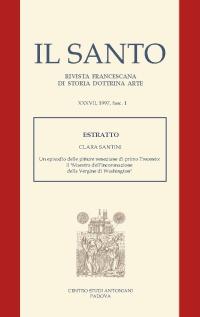Un episodio della pittura veneziana del primo Trecento: il "Maestro dell'Incoronazione della Vergine di Washington"

estratto da "Il Santo", XXXVII (1997), 1
SOMMARIO
La tavola datata 1324 della National Gallery di Washington, raffigurante l'Incoronzione della Vergine, costituisce il perno attorno al quale ruota la ricostruzione del corpus di un anonimo artista veneziano, il cosiddetto «Maestro dell'Incoronazione della Vergine di Washington».
Col presente intervento si è inteso proporne un catalogo organico delle opere, cercando, nel contempo, di individuarne le fasi di sviluppo del peculiare registro espressivo, la cui parabola evolutiva può considerarsi già conclusa nella seconda metà del terzo decennio del XIV secolo e che appare ancora saldamente ancorato ai modelli della tradizione pittorica lagunare duecentesca. In tale contesto è stata brevemente presa in esame l'opera del «Maestro di San Zan Degolà», come anche la produzione del cosiddetto «Maestro della Cappella Dotto».
All'interno del corpus di quest'ultimo si è voluto conferire particolare rilievo al grande Crocifisso dipinto in Santa Maria dei Frari che, inaspettatamente restituito all'attenzione della critica da un recente intervento di restauro, risulta essere l'unica fra le opere sicuramente attribuibili all'anonimo artista a trovarsi ancora in Venezia.
SUMMARY
The painting dated 1324 of the Washington National Gallery representing the Coronation of the Virgin is the reference point for the reconstruction of the work of an anonymous Venetian artist called the "Master of the Washington Coronation of the Virgin".
The present dissertation is meant to provide a systematic catalogation of his works in order to analyse the development of the painter's artistic expressiveness. It ended between 1335 and 1340 and was stilI very close to the Thirteenth Century lagoon painting tradition.
In this contest, the work of the "M aster of San Zan Degolà" as well as that of the "Master of Dotto Chapel" haven been examined. As for the latter's work, the big Crucifzx has been given a particular attention. It was painted in Santa Maria dei Frari Church and after a recent restoration, has been revalued by the critics; now, it is considered as the only work existing in Venice this artist surely made.

